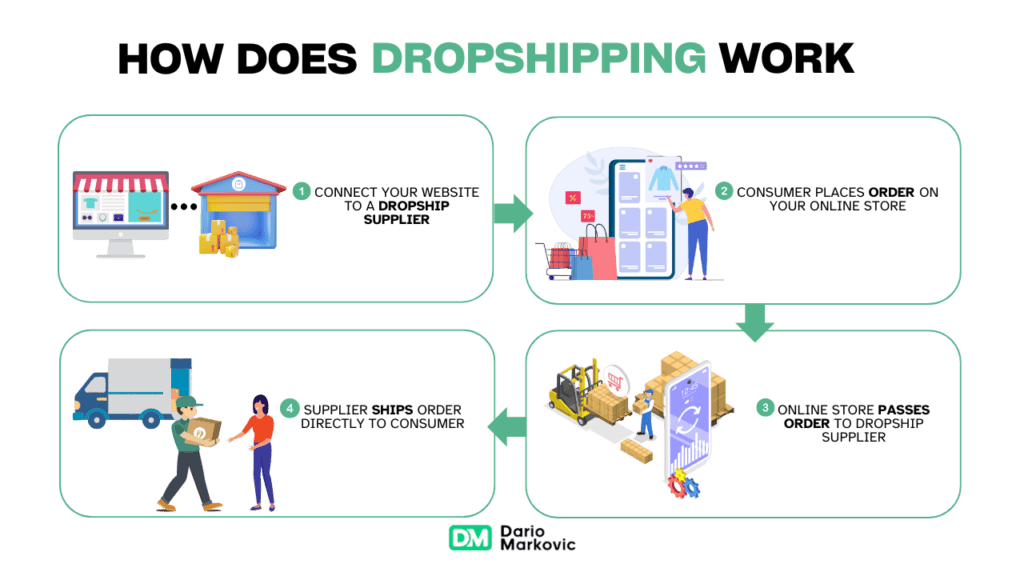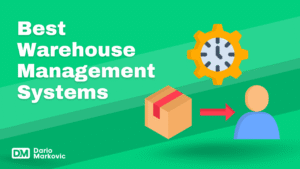The e-commerce world is thriving, offering lucrative opportunities for aspiring entrepreneurs.
Two standout business models, Dropshipping vs Amazon FBA, provide unique avenues to enter this competitive space, each with its own distinct advantages and challenges.
Dropshipping offers a low-cost entry by eliminating the need for inventory, while Amazon FBA leverages Amazon’s powerful fulfillment network to handle logistics, giving you access to a vast customer base. But which model aligns best with your goals?
Read on to discover a detailed comparison of Dropshipping and Amazon FBA, including their pros, cons, and key differences, so you can confidently choose the right path for your e-commerce success.
Understanding Dropshipping and Amazon FBA
Dropshipping
Dropshipping is a ecommerce business model that’s particularly appealing for those who want to start an e-commerce venture with minimal initial investment. Here’s how it works:
- Selection of Products: The seller selects a range of products to offer on their online store.
- Partnership with Suppliers: Sellers partner with third-party suppliers who manage the inventory and ship products directly to customers.
- Customer Orders: When a customer places an order, the seller forwards this order to the supplier.
- Fulfillment: The supplier then ships the product directly to the customer.
This means sellers don’t need to worry about stocking inventory, managing warehouses, or dealing with shipping logistics. It’s a low-risk entry point into e-commerce, especially for those new to the industry.
How Does Dropshipping Work with Third-Party Suppliers?
- Inventory Management: Suppliers hold the stock and manage inventory levels.
- Order Processing: Sellers communicate customer orders to suppliers.
- Shipping and Handling: Suppliers are responsible for packaging and shipping products to customers.

For anyone looking into dropshipping, connecting with reliable dropshipping suppliers is crucial. Websites like AliExpress, Oberlo, and SaleHoo are popular choices among beginners.
Amazon FBA (Fulfillment by Amazon)
Amazon FBA offers a different approach where sellers leverage Amazon’s vast logistics network for storing, packing, and shipping their products. Here’s how it operates:
- Inventory Shipment: Sellers send their inventory to Amazon’s fulfillment centers.
- Storage: Amazon stores these products in their warehouses until orders come in.
- Order Fulfillment: When a customer places an order on Amazon, the platform takes care of picking, packing, and shipping the product.
- Customer Service: Amazon also handles returns and customer inquiries.
This model allows sellers to benefit from Amazon’s robust logistics system, including fast shipping times through Amazon Prime.
How Do Sellers Utilize Amazon’s Fulfillment Centers?
- Amazon Seller Central: Sellers manage their listings and monitor inventory through this platform.
- FBA Benefits: Access to Prime customers, efficient storage solutions, professional packing services, and streamlined returns handling.
Leveraging Fulfillment by Amazon can lead to increased sales due to faster delivery options and improved customer trust associated with buying through Amazon’s platform.
Both dropshipping and FBA have unique operational processes that cater to different business needs and goals. Understanding these models helps in making informed decisions about which path might be best suited for your e-commerce journey. For instance, if you’re considering dropshipping on Amazon, you might find this Amazon drop shipping guide useful. Alternatively, if you’re interested in selling on Amazon without holding inventory, you could explore some strategies outlined in this article on how to sell on amazon without inventory.
Weighing the Pros and Cons: Dropshipping vs. Amazon FBA
Advantages of Dropshipping
- No need to purchase inventory in bulk.
- Avoids costs associated with warehousing and storage.
- Ability to offer a wide range of products without stocking any physical inventory.
- Easier to test new products and niches without significant financial risk.
Reduced Operational Hassles:
- Suppliers handle shipping, packaging, and inventory management.
- Focus can be on marketing and customer acquisition.
Disadvantages of Dropshipping
- High Competition:
- Low entry barriers lead to saturated markets.
- Difficult to maintain competitive pricing.
- Quality Control Issues:
- Less control over product quality and shipping times.
- Potential for higher return rates due to inconsistent supplier performance.
- Customer Service Challenges:
- Issues with handling returns and refunds effectively.
- Dependence on third-party suppliers can affect customer satisfaction.
Advantages of Amazon FBA
- Products listed as Prime eligible, attracting more customers.
- Fast shipping options enhance customer satisfaction.
Streamlined Fulfillment:
- Amazon handles storage, packing, shipping, and customer service.
- Focus can be on sales strategies and growth.
Enhanced Credibility:
- Selling through Amazon instills trust in potential buyers.
- Better control over returns and customer service processes.
Disadvantages of Amazon FBA
- Upfront Costs:
- Significant investment required for purchasing inventory.
- Additional costs include FBA fees such as storage fees, pick-and-pack fees, and long-term storage fees.
- Inventory Risks:
- Risk of unsold inventory leading to additional storage costs.
- Need for effective inventory management to avoid stockouts or excess stock.
- Dependence on Amazon’s Policies:
- Changes in Amazon’s terms or fee structures can impact profitability.
- Sellers must adhere strictly to Amazon’s guidelines, limiting flexibility.
Both dropshipping income potential and FBA success are influenced by various factors like market demand, competition, and operational efficiency. Each model has unique financial considerations that can impact your bottom line significantly.
Key Differences Between Dropshipping and Amazon FBA You Need to Know
When you compare dropshipping and Amazon FBA, understanding their key differences can guide your choice. Here’s a closer look at how these models stack up against each other:
Inventory Management
- Supplier-Managed (Dropshipping): In dropshipping, the supplier handles inventory management. This means sellers don’t need to invest in stock or worry about warehousing. The supplier keeps the products and sends them directly to the customer once an order is placed.
- Seller-Managed (Amazon FBA): With Amazon FBA, sellers purchase and store their inventory in Amazon’s fulfillment centers. They must manage stock levels and ensure timely replenishment. While this involves more upfront investment, it allows for better control over inventory.
Shipping and Fulfillment Processes
- Third-Party Reliance (Dropshipping): Shipping times and processes in dropshipping are managed by the third-party supplier. This can lead to variability in delivery times and potential delays, especially if the supplier is overseas.
- Amazon Logistics (Amazon FBA): Amazon handles all shipping and fulfillment for FBA sellers using its extensive logistics network. This results in faster and more reliable shipping options, including access to Amazon Prime’s two-day delivery service.
Control Over Customer Experience
- Customer Service Dynamics in Dropshipping: Sellers have limited control over customer service aspects like returns, refunds, and product quality since these elements depend largely on the supplier’s policies and practices. This can lead to inconsistencies in customer experience.
- Customer Service Dynamics in Amazon FBA: Amazon manages returns, refunds, and customer inquiries for FBA sellers. This ensures a more consistent customer service experience but means that sellers must adhere to Amazon’s strict guidelines.
By examining these facets—inventory management, shipping processes, and control over customer experience—it becomes evident that both models offer unique benefits tailored to different business needs. Understanding these distinctions can help you select the best approach for your e-commerce venture.
Dario`s Final Thoughts
Choosing between Dropshipping and Amazon FBA depends on your business goals, resources, and preferences. Dropshipping is ideal for those with minimal upfront investment and a need for flexibility, but it comes with challenges like high competition and less control over shipping and customer service.
Amazon FBA, while requiring more capital for inventory, offers better control over shipping and customer experience, leveraging Amazon’s logistics for quicker deliveries. Dropshipping benefits include low initial investment and flexibility, while its downsides are high competition and limited control.
Amazon FBA offers access to Prime customers and superior customer service, but it involves higher costs and storage fees.
Frequently Asked Questions about Dropshipping vs Amazon FBA
What are some disadvantages of using Amazon FBA?
Some disadvantages of Amazon FBA include potentially high fees that can eat into profit margins, less control over inventory management since it’s handled by Amazon, and reliance on Amazon’s policies which can change at any time affecting seller operations.
Where can I find more resources to learn about dropshipping and Amazon FBA?
You can explore various online courses, e-books, blogs, and forums dedicated to e-commerce. Many platforms offer comprehensive guides on both dropshipping and Amazon FBA that can help deepen your understanding of each model.
What are the main advantages of dropshipping?
The main advantages of dropshipping include lower startup costs since you don’t need to invest in inventory upfront, flexibility in terms of location as you can run your business from anywhere with internet access, and a wide product selection since you can offer items from various suppliers without holding stock.
What is Amazon FBA and how does it operate?
Fulfillment by Amazon (FBA) is a service provided by Amazon that allows sellers to store their products in Amazon’s fulfillment centers. Amazon takes care of storage, packaging, shipping, and customer service on behalf of the seller, allowing them to leverage Amazon’s extensive logistics network.
What is dropshipping and how does it work?
Dropshipping is a retail fulfillment method where a store doesn’t keep the products it sells in stock. Instead, when a store sells a product, it purchases the item from a third-party supplier who then ships it directly to the customer. This means that the seller never sees or handles the product.



